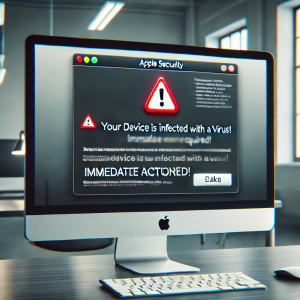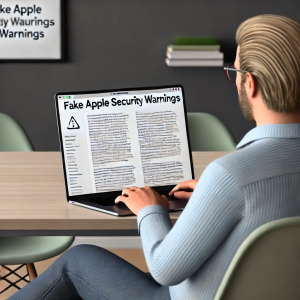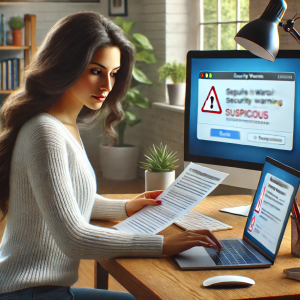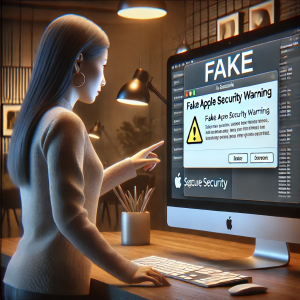Fake Apple Security Warning
In today’s digital era, the surge in cybersecurity threats is a growing concern, particularly for Apple users. The allure of Apple’s ecosystem for its robust security features ironically makes it a prime target for scammers, leading to an uptick in Apple security warnings. Among these are numerous deceptive alerts designed to exploit users. Recognizing these fraudulent messages is crucial, not only to safeguard your personal information but to maintain the integrity of your digital life.
The purpose of this blog is to equip you with the necessary knowledge to discern genuine Apple security alert pop ups from malicious attempts. Misleading fake AppleCare virus warnings and other bogus Apple security virus alerts have become increasingly sophisticated, making it challenging to identify them at first glance. These fake alerts can range from Apple warning messages about non-existent viruses to Apple spyware warnings that falsely claim your device is compromised.
Understanding how to spot and respond to these deceptive tactics is more than just a skill—it’s an essential defense mechanism. This blog aims to not only highlight the characteristics of these scams but also to provide practical advice on how to handle them if you encounter one. Whether you come across a real Apple security alert or a cunning imitation, the information here will help you sail these turbulent waters with confidence, ensuring your data remains secure and your experience with Apple products remains positive.
What are Fake Apple Security Warnings?
Fake Apple security warnings are deceptive alerts crafted by cybercriminals to mimic legitimate notifications from Apple. The primary intent behind these scams is to instill panic and trick users into providing sensitive information, downloading malware, or inadvertently granting access to their devices. Unlike a real Apple security alert, these fraudulent messages are characterized by several red flags that can help you distinguish them from genuine communications.
Characteristics of Fake Apple Warning Message
-
Urgency:
One of the most common tactics used in fake Apple security warnings is the creation of a sense of urgency. The message may claim that immediate action is required to prevent account suspension or loss of data. Such pressure tactics are designed to provoke quick reactions without careful scrutiny.

-
Requests for Personal Information:
No legitimate Apple security virus alert will ask for your personal credentials, such as passwords or Social Security numbers, directly through an alert pop-up.
-
Grammar and Spelling Errors:
Professional communications from Apple are well-edited. In contrast, bogus Apple security virus alerts often contain grammatical mistakes and unusual phrasing, which are clear indicators of their illegitimacy.
-
Suspicious Links and Attachments:
Links to unrecognizable websites or requests to download files are major red flags. Genuine Apple malware alerts would never direct you to third-party websites for updates or fixes.
By recognizing these characteristics and remaining vigilant, you can protect yourself from the potential harm posed by these sophisticated scams. Understanding the distinction between fake and real Apple security alerts and is crucial in maintaining your digital safety and ensuring that your personal information remains secure.
How to Identify Apple Security Warnings that are not Legitimate
Identifying fake Apple security warnings is critical to protecting your personal and device security. Cybercriminals often craft these deceptive messages with subtle nuances that can fool even the vigilant user. However, by paying close attention to a few key indicators, you can effectively distinguish a fake Apple security warning from a real one.
Key Criteria to Identify Fake Alerts
-
Check the URL or Domain Name:
Authentic Apple messages will always direct you to a website with a legitimate Apple domain, such as apple.com or one of its secure subdomains. Be wary of any alert that includes links to external sites that look suspicious or use misleading domain names designed to appear close to the real thing, like apple-security.com or support-apple.com.

-
Evaluate the Language and Tone:
Apple security virus alerts are written with a professional tone, free of emotional language that presses for urgency. Fake Apple security warnings often contain alarming language to create a sense of immediate danger or urgency, pushing you to act fast without thinking. Also, look out for poor grammar, spelling mistakes, and awkward phrasing, which are likely absent in genuine Apple security alert pop ups.
-
Scrutinize Requests for Immediate Action or Personal Information:
A legitimate Apple spyware warning would not ask for your personal information such as passwords, PINs, or banking details directly through an alert. Be cautious if the message urges immediate action like installing software, clicking a link, or entering personal details, as these are common tactics in phishing scams.
-
Type of Request Made:
Messages that claim your Apple device is infected with a virus and require you to download an obscure tool or visit an external website are clear indicators of a scam. Apple’s real notifications will guide you through standard procedures within your device settings or the official Apple website.
Additional Tips
- Always verify the authenticity of any suspicious message by directly contacting Apple Support through their official channels.
- Regularly update your device’s operating system and applications to protect against known vulnerabilities and minimize the risk of falling prey to scams.
- Educate yourself about the latest phishing techniques. Cyber threats evolve constantly, and staying informed is your best defense against new types of scams.
By maintaining a cautious approach and scrutinizing the details of any Apple security alert pop up or warning message you receive, you can effectively shield yourself from the threats posed by these bogus Apple warning messages. Remember, when in doubt, it’s always safer to ignore the message and verify its authenticity through official Apple channels.
The Impact of Falling for Fake Security Warnings of Apple
Responding to fake Apple security warnings can lead to dire consequences for Apple users, ranging from mild inconveniences to severe financial and personal repercussions. Recognizing these fraudulent alerts is not just about maintaining the functionality of your device but protecting your entire digital identity.
Consequences of Falling for Apple Security Warning Scam Pop ups
-
Malware Installation:
One of the most common outcomes of clicking on a fake Apple security warning is the installation of malware on your device. This malicious software can be disguised as necessary security updates or software tools prompted by an Apple security virus alert. Once installed, malware can compromise your device’s integrity by allowing cybercriminals to take control, access sensitive information, or use your device as part of larger network attacks.

-
Financial Loss:
Phishing attempts, often delivered through AppleCare virus warnings can trick you into providing financial information such as payment card numbers or banking details. These details can then be used to make unauthorized transactions or steal your identity, leading to significant financial loss and a lengthy resolution process.
-
Data Theft:
Personal and sensitive data can also be at risk if you heed a fake Apple security warning. Cybercriminals could gain access to your personal photos, documents, emails, and other valuable information. This data could be used for blackmail, sold on the dark web, or leveraged to breach further secured environments.
-
Loss of Privacy:
Apple spyware warnings that turn out to be fake can lead to actual spyware installations, compromising your privacy. This type of malware allows attackers to monitor your activities, track your location, and even activate hardware such as cameras and microphones without your consent.
-
Damage to Reputation:
If your professional data is compromised because of a response to a fake Apple security warning, it can lead to reputational damage. This is particularly detrimental if sensitive business information is leaked or if your business contacts are targeted through your compromised accounts.
Minimizing Risk
To avoid these severe outcomes, it is crucial to:
- Verify the authenticity of any apple security alert pop up directly through official Apple channels.
- Educate yourself and others about the signs of a fake Apple security warning.
- Maintain robust security practices, including regular updates and the use of reputable security software.
Understanding the grave implications of falling for bogus apple virus messages and other deceptive security alerts can enable you to respond proactively in safeguarding your digital life. Always approach unsolicited security communications with skepticism and prioritize verifying their legitimacy through reliable sources.
Steps to Take if You Receive a Suspicious Apple Security Warning
When you get a suspicious Apple security warning pop up, it’s crucial to handle it carefully to protect your device and personal information. Here’s a simpler guide on what to do if you suspect a security warning is not genuine.
How to Verify the Authenticity of an AppleCare Virus Warning
-
Avoid Interaction:
Do not click or interact with the fake Apple security warning in any way, as this might activate malicious software.
-
Check Official Sources:
Log into your Apple account through trusted channels like the Apple Support app to see if there are any genuine Apple security virus alerts related to your account.

-
Examine the Source:
Look closely at any URL shown in the warning. Authentic alerts should direct you only to ‘apple.com’ domains. Anything else could indicate a bogus Apple warning message.
-
Search Online:
Google the text or description of the alert to see if it’s a known scam. Often, new AppleCare virus warnings are reported and identified quickly online.
Reporting Suspicious Security Warnings to Apple
-
Document the Alert:
Take a screenshot of the Apple device virus warning, capturing URLs and other details, but do not interact with it.
-
Contact Apple Support:
Reach out to Apple Support through their official channels to report the fake security warning. Provide all the details you’ve collected.
-
Use Apple’s Reporting Tools:
Forward suspicious emails to [email protected], and use Apple’s support website to report fake pop-ups.
Securing Your Apple Devices After Exposure
-
Update Passwords:
Change your Apple ID password immediately if you think your device might be compromised by a fake Apple security warning.
-
Turn on Two-Factor Authentication:
Secure your account further by enabling two-factor authentication, adding an extra layer of security against unauthorized access from Apple security virus alerts.
-
Install Updates:
Keep your device’s software up-to-date to protect against vulnerabilities that could be exploited by malware from a fake Apple security warning.
-
Install Security Software:
Use reputable security software for added protection, especially if you’ve encountered an apple device virus warning.
-
Stay Informed:
Keep up with the latest security threats and educate others on how to recognize a fake Apple security warning to prevent future scams.
By applying these straightforward steps, you can safely manage any Apple security alert pop up and enhance your device’s defense against potential cyber threats.
Preventive Measures to Avoid Fake AppleCare Virus Warnings
In the fight against cyber threats, prevention is just as crucial as detection. By taking proactive steps, you can significantly reduce the risk of falling victim to a fake Apple security warning. Here’s how to bolster the defenses of your Apple devices against these deceptive alerts.
Enhancing Security Settings on Apple Devices
-
Update Regularly:
Always keep your software up-to-date. Apple frequently releases updates to patch vulnerabilities that could be exploited by malware. Each update enhances your protection against potential Apple malware alerts and Apple security virus alerts.
-
Adjust Privacy Settings:
Review and tighten your device’s privacy settings. Limit app permissions to only those necessary for functionality. This helps prevent malicious apps from exploiting permissions to issue fake Apple security warnings.
-
Enable Two-Factor Authentication:
For any service that provides it, especially your Apple ID, enable two-factor authentication. This adds an extra layer of security, making it much harder for attackers to gain unauthorized access even if they issue a real Apple security alert as part of a phishing attempt.
Recommended Software Updates and Security Tools
-
Use Reputable Antivirus Software:
Install and maintain reputable antivirus software to protect against Apple spyware warnings and Apple device virus warnings. These tools can identify and remove malicious software before it can do any harm.
-
Install a VPN:
Use a Virtual Private Network when accessing public Wi-Fi networks to encrypt your internet connection and protect your data from interceptors using fake Apple security warnings to capture sensitive information.
-
Backup Your Data:
Regularly back up your data. This ensures that you can restore your information if you ever fall prey to a scam that leads to data loss following an Apple warning about virus or malware.
The Importance of Ongoing Cybersecurity Education and Awareness
-
Stay Informed:
Keep up-to-date with the latest security threats and trends. This knowledge can help you identify and react appropriately to a fake Apple security warning.
-
Educational Workshops:
Participate in cybersecurity workshops and training sessions. These can provide valuable insights into recognizing and dealing with genuine and fake Apple security warning pop ups.
-
Promote Security Awareness:
Share your knowledge with friends, family, and colleagues. Educating others not only helps protect them but also creates a community vigilant against scams.
By implementing these preventive measures, you can enhance your device’s resilience against fake Apple security warnings and other cyber threats. Regular updates, appropriate security settings, and continuous education are your best defense in maintaining your digital security.
FAQs
Q1. What is a fake Apple security warning?
- A. A fake Apple security warning is a deceptive message that mimics real Apple security alerts to trick users into giving personal information or downloading malware. These are not legitimate and should be treated with caution.
Q2. How can I distinguish a fake Apple security alert pop up from a real one?
- A. Look for urgent language, requests for personal information, poor grammar, and check the URL if it’s visible; a genuine Apple security alert pop up will only direct you to an ‘apple.com’ domain.
Q3. What should I do if I receive an Apple security warning pop up that I suspect is fake?
- A. Do not interact with the pop-up. Instead, report the apple security warning pop up directly to Apple through their official support channels.
Q4. What should I do if I keep getting repeated security alerts on my iPhone?
- A. If you’re receiving repeated security alerts on your iPhone, it’s essential to verify whether these alerts are legitimate by checking your settings through the official Apple Support app or website. Do not interact with the alerts directly. If they’re persistent and you suspect they’re fake, report the issue to Apple Support for further assistance. You can also read our detailed blog on Fake Apple Security Warning on iPhone and get the issue resolved.
Q5. What are the common signs of an Apple spyware warning that might be fake?
- A. Common signs include grammatical errors, urgent requests to act immediately, and links that do not lead to the official Apple website. An authentic Apple spyware warning won’t ask for personal details directly through a pop-up.
Q6. Can a fake Apple security virus alert install malware on my device?
- A. Yes, clicking on links or downloading files from a fake Apple security virus alert can lead to malware installation, which may compromise your device’s security and personal data.
Q7. What are the risks of responding to an AppleCare virus warning that’s fake?
- A. Responding to a fake AppleCare virus warning can result in malware infections, data theft, or financial loss by mistakenly providing sensitive information or downloading harmful software.
Q8. What should I do to stop receiving an Apple malware alert?
- A. Keep your device’s software updated, use reputable antivirus software, enable two-factor authentication, and educate yourself on the latest cybersecurity practices to reduce the risk of encountering a fake Apple malware alert.
Q9. How can an Apple device virus warning impact my personal data?
- A. A fake Apple device virus warning can result in unauthorized access to your personal data if it tricks you into installing malware or revealing personal information.
Q10. Why is ongoing cybersecurity education important in recognizing Apple virus messages?
- A. Continuous education helps you stay updated on new phishing tactics and recognize signs of a fake Apple virus message, ensuring you and your data remain secure against emerging threats.
Conclusion
In our increasingly digital world, staying vigilant in cybersecurity is essential. This blog has covered how to distinguish fake Apple security warnings from real security alerts by scrutinizing warning signs such as unsolicited requests for personal information, urgency, and grammatical errors. If you encounter a suspicious Apple security warning pop up, it’s crucial not to interact with it but to report it directly to Apple. You can also call us on our customer support number mentioned on our Apple Support page. Our support team will assist you properly in resolving the issue. Protecting yourself also involves proactive measures like keeping your software up-to-date and enhancing your privacy settings.
Moreover, employing robust security tools is key to warding off potential Apple spyware warnings and Apple malware alerts. Continuously educating yourself about cybersecurity is vital to recognizing new threats, including AppleCare virus warnings. The landscape of cybersecurity threats constantly evolves; thus, maintaining an updated knowledge base and implementing a proactive security strategy are your best defenses. By adhering to these practices, you can safeguard your digital activities against the vast array of security threats in our connected world.

